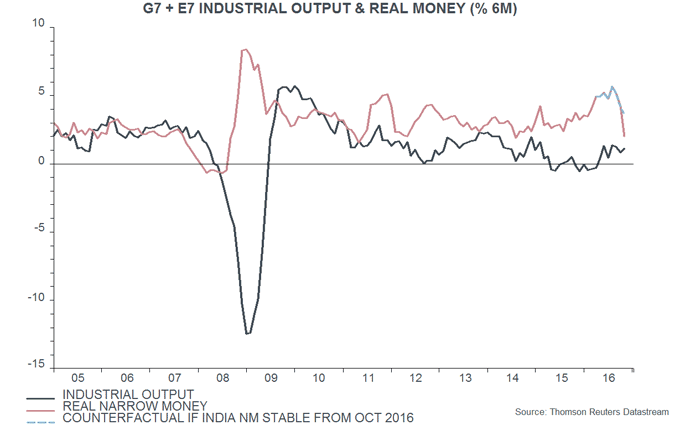Global economy strong but money trends cooling
Incoming news is consistent with the forecast here of a global economic “boomlet” in early 2017. Economic acceleration reflects a loosening of monetary conditions in early / mid 2016 but global real narrow money is now slowing, suggesting a loss of momentum in mid 2017. The combination of falling real money growth and rising economic growth may indicate reduced liquidity support for equity markets.
Global business survey results released this week have been strong. In the US, an average of the new orders components of the New York and Philadelphia Fed manufacturing surveys rose to the top of its historical range, suggesting that the new orders index of the national Institute for Supply Management (ISM) survey will move above 60 – see first chart.
In the Eurozone, the new orders index of the manufacturing purchasing managers’ survey rose to a 68-month high. The corresponding Japanese index also strengthened significantly and has yet to incorporate the full effect of recent yen weakness. In the UK, CBI manufacturing output expectations remained buoyant despite a modest recovery in sterling.
Emerging global economic strength was predicted by a surge in six-month growth of G7 plus E7 real narrow money to a peak in August 2016. This peak suggests that economic momentum will top out in spring 2017, allowing for an average nine-month lead. Incoming monetary data, meanwhile, hint at a significant subsequent slowdown.
A November estimate of the G7 plus E7 narrow money aggregate tracked here is now available but has been heavily distorted by India’s “demonetisation” programme, which has resulted in a 23% fall in the M1 money stock, partly reflecting a temporary shortage of replacement bank notes. This decline is very negative for Indian near-term economic prospects but the global implications are probably limited. Even assuming that Indian M1 had remained at its October level, however, six-month growth of G7 plus E7 real narrow money would have fallen further in November, based on available data* – second chart.
A slowdown in US real narrow money has been a key driver of the recent global decline: US six-month real money growth is at its lowest level since February, with a reduction in nominal expansion mainly responsible, rather than a pick-up in inflation. Japanese real money has also slowed sharply, while Chinese growth has moderated, though remains strong – third chart.
The formal equities versus cash switching rules described in a previous post recommend moving into cash if 1) G7 annual real narrow money growth falls beneath industrial output growth, 2) real money growth falls beneath 3% or 3) real money growth falls by 3 percentage points within six months. None of these conditions has yet been met. The real money / output growth gap, however, is narrowing, suggesting that the portion of money growth destined to flow into securities is diminishing. Markets, in other words, may have less liquidity “insulation” from negative shocks.
*November estimate based on c.70% data coverage; annual money growth assumed stable for missing countries.

Reader Comments